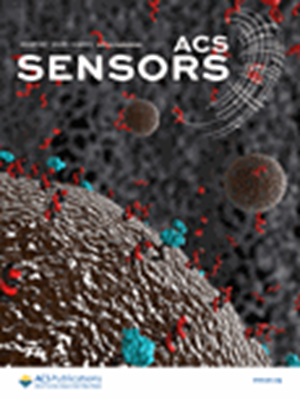基于MXene-Cu2O复合材料的超灵敏室温NO2气体传感器
IF 8.2
1区 化学
Q1 CHEMISTRY, ANALYTICAL
引用次数: 0
摘要
可在室温下操作的实时痕量二氧化氮定量平台的开发是职业安全和公共卫生监测系统的重要进步。本研究利用水热法制备的MXene-Cu2O复合材料制备了一种室温NO2传感器。系统评价了mxene引入的效果,发现0.84 wt %的MXene-Cu2O复合材料是最佳的,与纯Cu2O相比,灵敏度提高了4倍,响应时间(55 s)/恢复时间(35 s)更短。此外,该传感器具有低检测限(10 ppb)、高选择性、高可逆性和长期稳定性。增强的传感性能源于MXene和Cu2O之间精确设计的界面结构,该结构有效地调节了传感材料中通过传导隧道的电荷转移行为。此外,氧空位工程创造了缺陷介导的吸附中心,通过电荷极化效应促进NO2的选择性化学吸附。该研究为设计优化结构以提高mos基材料检测NO2气体的灵敏度提供了一种新的策略。本文章由计算机程序翻译,如有差异,请以英文原文为准。

Ultrasensitive Room-Temperature NO2 Gas Sensor Based on MXene–Cu2O Composites
The development of real-time trace-level NO2 quantification platforms that can be operated at room temperature constitutes a critical advancement for occupational safety and public health monitoring systems. This study demonstrates a room-temperature NO2 sensor using MXene–Cu2O composites prepared via a hydrothermal method. Systematic evaluation of MXene-introduced effects identified the 0.84 wt % MXene–Cu2O composite as optimal, exhibiting 4-fold enhanced sensitivity and shorter response (55 s)/recovery (35 s) time compared to pure Cu2O. Additionally, the sensor exhibits a low detection limit (10 ppb), high selectivity, great reversibility, and long-term stability. The enhanced sensing performance originates from precisely engineered interfacial architectures between MXene and Cu2O, which effectively adjust the charge-transfer behavior through the conduction tunnel in the sensing material. Furthermore, oxygen vacancy engineering creates defect-mediated adsorption centers that promote selective NO2 chemisorption through charge polarization effects. This research offers a novel strategy for designing optimized structures to enhance the sensitivity of MOS-based materials for NO2 gas detection.
求助全文
通过发布文献求助,成功后即可免费获取论文全文。
去求助
来源期刊

ACS Sensors
Chemical Engineering-Bioengineering
CiteScore
14.50
自引率
3.40%
发文量
372
期刊介绍:
ACS Sensors is a peer-reviewed research journal that focuses on the dissemination of new and original knowledge in the field of sensor science, particularly those that selectively sense chemical or biological species or processes. The journal covers a broad range of topics, including but not limited to biosensors, chemical sensors, gas sensors, intracellular sensors, single molecule sensors, cell chips, and microfluidic devices. It aims to publish articles that address conceptual advances in sensing technology applicable to various types of analytes or application papers that report on the use of existing sensing concepts in new ways or for new analytes.
 求助内容:
求助内容: 应助结果提醒方式:
应助结果提醒方式:


